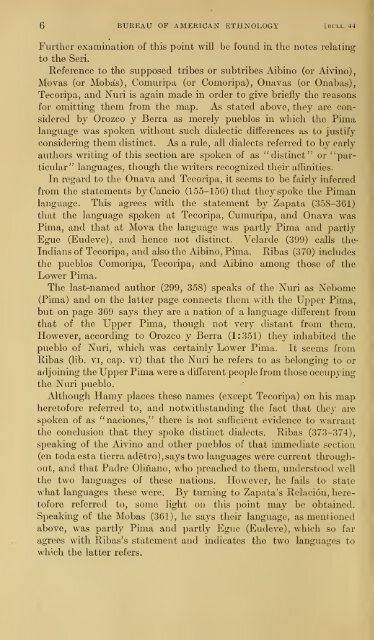Untitled - Smithsonian Institution
Untitled - Smithsonian Institution
Untitled - Smithsonian Institution
You also want an ePaper? Increase the reach of your titles
YUMPU automatically turns print PDFs into web optimized ePapers that Google loves.
6 BUREAU OF AMERICAN ETHNOLOGY [bull. 44<br />
Further examination of this point will be found in the notes relating<br />
to the Seri.<br />
Reference to the supposed tribes or subtribes Albino (or Aivino),<br />
Movas (or Mobas), Comuripa (or Comoripa), Onavas (or Onabas),<br />
Tecoripa, and Nuri is again made in order to give briefly the reasons<br />
for omitting them from the map. As stated above, they are considered<br />
by Orozco y Berra as merely pueblos in which the Pima<br />
language was spoken without such dialectic differences as to justify<br />
considering them distinct. As a rule, all dialects referred to by early<br />
authors writing of this section are spoken of as "distinct" or "par-<br />
ticular" languages, though the writers recognized their affinities.<br />
In regard to the Onava and Tecoripa, it seems to be fairly inferred<br />
from the statements byCancio (155-156) that they spoke the Piman<br />
language. This agrees with the statement by Zapata (358-361)<br />
that the language spoken at Tecoripa, Cumuripa, and Onava was<br />
Pima, and that at Mova the language was partly Pima and partly<br />
Egue (Eudeve), and hence not distinct. Velarde (399) calls the-<br />
Indians of Tecoripa, and also the Albino, Pima. Ribas (370) includes<br />
the pueblos Comoripa, Tecoripa, and Albino among those of the<br />
Lower Pima.<br />
The last-named author (299, 358) speaks of the Nuri as Nebome<br />
(Pima) and on the latter page connects them with the Upper Pima,<br />
but on page 369 says they are a nation of a language different from<br />
that of the Upper Pima, though not very distant from them.<br />
However, according to Orozco y Berra (1:351) they inhabited the<br />
pueblo of Nuri, which was certainly Lower Pima. It seems from<br />
Ribas (lib. vi, cap. vi) that the Nuri he refers to as belonging to or<br />
adjoining the Upper Pima were a different people from those occupying<br />
the Nuri pueblo.<br />
Although Hamy places these names (except Tecoripa) on his map<br />
heretofore referred to, and notwithstanding the fact that they are<br />
spoken of as "naciones," there is not sufficient evidence to warrant<br />
the conclusion that they spoke distinct dialects. Ribas (373-374),<br />
speaking of the Aivino and other pueblos of that immediate section<br />
(en todaesta tierra adetro), says two languages were current through-<br />
out, and that Padre Olinano, who preached to them, understood well<br />
the two languages of these nations. However, he fails to state<br />
what languages these were. By turnmg to Zapata's Relacion, here-<br />
tofore referred to, some light on this point may be obtained.<br />
Speaking of the Mobas (361), he says their language, as mentioned<br />
above, was partly Pima and partly Egue (Eudeve), which so far<br />
agrees with Ribas's statement and indicates the two languages to<br />
which the latter refers.

















